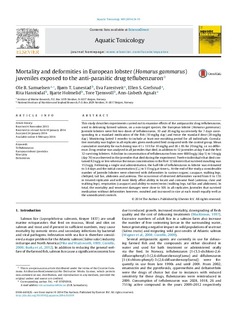| dc.contributor.author | Samuelsen, Ole Bent | |
| dc.contributor.author | Lunestad, Bjørn T. | |
| dc.contributor.author | Farestveit, Eva | |
| dc.contributor.author | Grefsrud, Ellen Sofie | |
| dc.contributor.author | Hannisdal, Rita | |
| dc.contributor.author | Holmelid, Bjarte | |
| dc.contributor.author | Tjensvoll, Tore | |
| dc.contributor.author | Agnalt, Ann-Lisbeth | |
| dc.date.accessioned | 2014-05-13T10:54:03Z | |
| dc.date.available | 2014-05-13T10:54:03Z | |
| dc.date.issued | 2014-02-04 | |
| dc.identifier.citation | Samuelsen OB, Lunestad BT, Farestveit E, Grefsrud ES, Hannisdal R, Holmelid B, Tjensvoll T, Agnalt A-L: Mortality and deformities in European lobster (Homarus gammarus) juveniles exposed to the anti-parasitic drug teflubenzuron. Aquatic Toxicology 2014, 149:8-15 | nb_NO |
| dc.identifier.issn | 1879-1514 | |
| dc.identifier.issn | 0166-445x | |
| dc.identifier.uri | http://hdl.handle.net/11250/194940 | |
| dc.description.abstract | This study describes experiments carried out to examine effects of the antiparasitic drug teflubenzuron, used in delousing farmed salmon, on a non-target species, the European lobster (Homarus gammarus). Juvenile lobsters were fed two doses of teflubenzuron, 10 and 20mg/kg successively for 7 days corresponding to a standard medication of the fish (10mg/kg day) and twice the standard dose (20mg/kg day). Monitoring lasted 3 months to include at least one moulting period for all individuals. Cumulative mortality was higher in all replicates given medicated feed compared with the control group. Mean cumulative mortality for each dosing was 41 13% for 10mg/kg and 38 8% for 20mg/kg, i.e. no difference. Drug residue was analysed in all juveniles that died, in addition to 12 juveniles at day 8 and the first 12 surviving lobsters. A decline in concentration of teflubenzuron from over 8,000 ng/g (day 5) to 14 ng/g (day 70) was observed in the juveniles that died during the experiment. Twelve individuals that died contained 82 ng/g or less whereas the mean concentration in the first 12 lobsters that survived moulting was 152 ng/g. Following a single oral administration, the half-life of teflubenzuron in lobster was estimated to 3.4 days and the initial concentration (C0) to 515 ng/g at time t0. At the end of the study a considerable number of juvenile lobsters were observed with deformities in various organs; carapace, walking legs, cheliped, tail fan, abdomen and antenna. The occurrence of observed deformities varied from 0 to 15% in treated replicates and will most likely affect ability to locate and consume food (antenna, claw and walking legs), respiration (carapace) and ability to move/swim (walking legs, tail fan and abdomen). In total, the mortality and senescent damages were close to 50% in all replicates. Juveniles that survived medication without deformities however, moulted and increased in size at each moult equally well as the unmedicated controls. | nb_NO |
| dc.language.iso | eng | nb_NO |
| dc.publisher | Elsevier | nb_NO |
| dc.subject | VDP::Landbruks- og Fiskerifag: 900::Fiskerifag: 920::Fiskehelse: 923 | nb_NO |
| dc.title | Mortality and deformities in European lobster (Homarus gammarus) juveniles exposed to the anti-parasitic drug teflubenzuron | nb_NO |
| dc.type | Journal article | nb_NO |
| dc.type | Peer reviewed | nb_NO |
| dc.source.pagenumber | 8-15 | nb_NO |
| dc.source.volume | 149 | nb_NO |
| dc.source.journal | Aquatic Toxicology | nb_NO |
| dc.identifier.doi | 10.1016/j.aquatox.2014.01.019 | |
